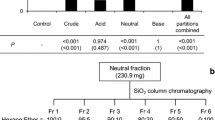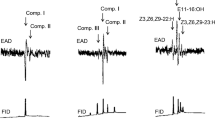Abstract
The cuticular surface of sexually mature females of the German cockroach contains a sex pheromone that, upon contact with the male’s antennae, elicits a characteristic species-specific courtship behavior. This female-specific pheromone is a blend of several long-chain methyl ketones, alcohols and aldehydes, all derived from prominent cuticular hydrocarbons found in all life stages of this cockroach. We found that contact with the antennae of 5 out of 20 assayed cockroach species elicited courtship behavior in German cockroach males. The heterospecific courtship-eliciting compounds were isolated by behaviorally guided fractionation of the active crude extracts and compared to the native sex pheromone components. We identified two active compounds from the cuticular extract of the Oriental cockroach, Blatta orientalis—11-methylheptacosan-2-one and 27-oxo-11-methylheptacosan-2-one; the former compound was confirmed by synthesis and proved to independently stimulate courtship in German cockroach males. These compounds share common features with, but are distinct from, any of the known contact sex pheromone components. This suggests that sex pheromone reception in the male German cockroach is unusually promiscuous, accepting a wide range of compounds that share certain features with its native pheromone, thus resulting in a broad spectrum of behavioral response to other species. We propose that several characteristics of their mating system—chiefly, absence of closely related species in the anthropogenic environment, resulting in relaxation of selection on sexual communication, and a highly male-biased operational sex ratio—have driven males to respond with extremely low thresholds to a wide spectrum of related compounds.



Similar content being viewed by others
References
Ahn K-C, Jung J-C, Park O-S (2006) A simple and cost effective synthesis of 3,11-dimethylnonacosan-2-one, a female sex pheromone of the German cockroach. Molecules 11:751–757
Augustynowicz M, Malinski E, Warnke Z, Szafranek J, Nawrot J (1987) Cuticular hydrocarbons of the German cockroach, Blattella germanica L. Comp Biochem Physiol B 86:519–523
Baker TC, Fadamiro HY, Cossé AA (1998) Moth uses fine tuning for odour resolution. Nature 393:530
Carlson DA, Brenner RJ (1988) Hydrocarbon-based discrimination of three North American Blattella cockroach species (Orthoptera: Blattellidae) using gas chromatography. Ann Entomol Soc Am 81:711–723
Charlton RE, Webster FX, Zhang A, Schal C, Liang D, Sreng I, Roelofs WL (1993) Sex pheromone for the brownbanded cockroach is an unusual dialkyl-substituted α-pyrone. Proc Natl Acad Sci USA 90:10202–10205
Chase J, Touhara K, Prestwich GD, Schal C, Blomquist GJ (1992) Biosynthesis and endocrine control of the production of the German cockroach sex pheromone 3,11-dimethylnonacosan-2-one. Proc Natl Acad Sci USA 89:6050–6054
Cornwell PB (1968) The cockroach, vol. 1. Hutchinson, London
Coyne JA, Orr HA (2004) Speciation. Sinauer Associates, Sunderland
Eliyahu D (2007) Chemical communication in the German Cockroach: pheromones and heterospecific courtship eliciting compounds. Ph.D. dissertation, North Carolina State University, Raleigh
Eliyahu D, Mori K, Takikawa H, Leal WS, Schal C (2004) Behavioral activity of stereoisomers and a new component of the contact sex pheromone of female German cockroach, Blattella germanica. J Chem Ecol 30:1839–1848
Eliyahu D, Nojima S, Mori K, Schal C (2008) New contact sex pheromone components of the German cockroach, Blattella germanica, predicted from the proposed biosynthetic pathway. J Chem Ecol (in press). DOI 10.1007/s10886-007-9409-8
Gemeno C, Schal C (2004) Sex pheromones of cockroaches. In: Cardé RT, Millar JG (eds) Advances in insect chemical ecology. Cambridge University Press, Cambridge, pp 179–247
Groot AT, Horovitz JL, Hamilton J, Santangelo RG, Schal C, Gould F (2006) Experimental evidence for interspecific directional selection on moth pheromone communication. Proc Natl Acad Sci USA 103:5858–5863
Jurenka RA, Schal C, Burns E, Chase J, Blomquist GJ (1989) Structural correlation between cuticular hydrocarbons and female contact sex pheromone of German cockroach Blattella germanica (L.). J Chem Ecol 15:939–949
Lockey KH, Dularay B (1986) Cuticular methylalkanes of adult cockroaches, Blatta orientalis and Periplaneta americana. Comp Biochem Physiol B 85:567–572
Löfstedt C (1993) Moth pheromone genetics and evolution. Phil Trans R Soc Lund B 340:167–177
Mori K (1998) Chirality and insect pheromones. Chirality 10:578–586
Mullins DE, Keil CB, White RH (1992) Maternal and paternal nitrogen investment in Blattella germanica (L) (Dictyoptera, Blattellidae). J Exp Biol 162:55–72
Nishida R, Fukami H (1983) Female sex pheromone of the German cockroach, Blattella germanica. Mem Coll Agric Kyoto Univ 122:1–24
Nojima S, Nishida R, Kuwahara Y, Sakuma M (1999) Nuptial feeding stimulants: a male courtship pheromone of the German cockroach, Blattella germanica (L.) (Dictyoptera: Blattellidae). Naturwissenschaften 86:193–196
Nojima S, Schal C, Webster FX, Santangelo RG, Roelofs WL (2005) Identification of the sex pheromone of the German cockroach, Blattella germanica. Science 307:1104–1106
Roth LM (1985) A taxonomic revision of the genus Blattella Caudell (Dictyoptera, Blattaria: Blattellidae). Entomol Scan Suppl 22:1–221
Roth LM, Willis ER (1952) A study of cockroach behavior. Am Midl Nat 47:66–129
Schal C, Burns EL, Jurenka RA, Blomquist GJ (1990) A new component of the female sex pheromone of Blattella germanica (L.) (Dictyoptera: Blattellidae) and interaction with other pheromone components. J Chem Ecol 16:1997–2008
Wyatt TD (2005) Pheromones: convergence and contrasts in insects and vertebrates. In: Mason RT, LeMaster MP, Müller-Schwarze D (eds) Chemical signals in vertebrates, vol. 10. Springer, New York, pp 7–20
Zhang A, Oliver JE, Chauhan K, Zhao B, Xia L, Xu Z (2003) Evidence for contact sex recognition pheromone of the Asian longhorned beetle, Anoplophora glabripennis (Coleoptera: Cerambycidae). Naturwissenschaften 90:410–413
Acknowledgements
We appreciate the help of Jinping Sun, Jeffrey Spontak, and Richard Santangelo in insect rearing and technical support. We thank Robert Anholt, Edward Vargo, and Charles Apperson for constructive comments on the manuscript and Cavell Brownie for assistance with statistical analysis. Mass spectra of synthetic intermediates were obtained by Matthew Lyndon at the Mass Spectrometry Laboratory for Biotechnology. Partial funding for the facility was obtained from the North Carolina Biotechnology Center, North Carolina State University Department of Chemistry, and the National Science Foundation. This work was funded in part by the Blanton J. Whitmire Endowment at North Carolina State University.
Author information
Authors and Affiliations
Corresponding author
Electronic supplementary material
Below is the link to the electronic supplementary material.
Electronic supplementary material
(DOC 47 kb).
Rights and permissions
About this article
Cite this article
Eliyahu, D., Nojima, S., Capracotta, S.S. et al. Identification of cuticular lipids eliciting interspecific courtship in the German cockroach, Blattella germanica . Naturwissenschaften 95, 403–412 (2008). https://doi.org/10.1007/s00114-007-0339-7
Received:
Revised:
Accepted:
Published:
Issue Date:
DOI: https://doi.org/10.1007/s00114-007-0339-7




